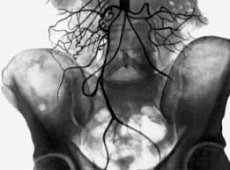Medical expert of the article
New publications
Leriche's syndrome
Last reviewed: 07.07.2025

All iLive content is medically reviewed or fact checked to ensure as much factual accuracy as possible.
We have strict sourcing guidelines and only link to reputable media sites, academic research institutions and, whenever possible, medically peer reviewed studies. Note that the numbers in parentheses ([1], [2], etc.) are clickable links to these studies.
If you feel that any of our content is inaccurate, out-of-date, or otherwise questionable, please select it and press Ctrl + Enter.

Leriche syndrome is a symptom complex caused by chronic occlusion of the bifurcation of the abdominal aorta and iliac vessels. A distinction is made between a congenital form caused by aortic hypoplasia or fibromuscular dysplasia of the iliac vessels; and an acquired form, which in 90% of cases is caused by the development of atherosclerosis and in 10% of cases by aortoarteritis.
Symptoms Leriche syndrome
Clinically, Leriche syndrome, in addition to the symptom of intermittent claudication, coldness and numbness of the lower extremities, is characterized by hair loss on the legs, slow nail growth, muscle atrophy and hypotrophy, and impotence often develops.
There is no pulsation of the arteries on the feet, in the popliteal fossa, or on the femoral artery upon palpation. However, systolic noise is detected upon auscultation of the iliac and femoral vessels.
Leriche syndrome has a pathognomonic symptom - the absence of pulsation, but the presence of systolic murmur.
Where does it hurt?
What's bothering you?
Stages
Leriche syndrome and its clinical picture depend on the extent and level of occlusion, as well as on the state of collateral blood flow. According to the proximal level of occlusion, there are 3 variants:
- low - below the level of the inferior mesenteric artery;
- middle - above the level of the inferior mesenteric artery;
- high - below or at the level of the renal vessels.
Depending on the level of distal occlusion, there are 4 types:
- aortic and common iliac lesions;
- damage to the aorta, common and external iliac branches;
- in the second type, the superficial femoral artery is additionally affected;
- Additionally, the vessels of the lower leg are affected.
Leriche syndrome has 4 degrees of ischemia: I - initial manifestations; IIA - the appearance of intermittent claudication after 300-500 m of walking; IIB - the appearance of intermittent claudication after 200 meters of walking; III - pain after 25-50 m of walking or at rest; IV - the presence of ulcerative-necrotic changes.
Diagnostics Leriche syndrome
Instrumental studies mainly use functional ones: rheovasography, ultrasound Dopplerography, oscillography, plethysmography, etc., which will reveal Leriche syndrome and blood flow disorders in the vessels of the lower extremities. Topical diagnostics is carried out by X-ray contrast aortography, but it is carried out only if the question of surgical treatment is raised.


 [
[